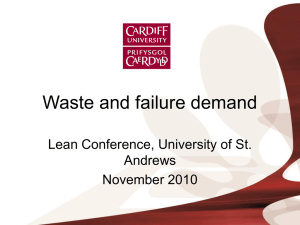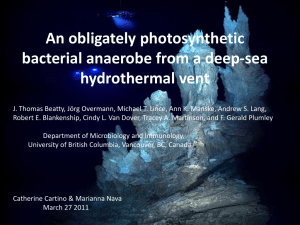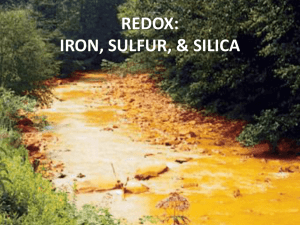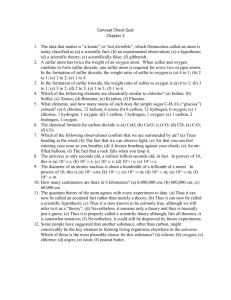Proposal - Oncourse
advertisement
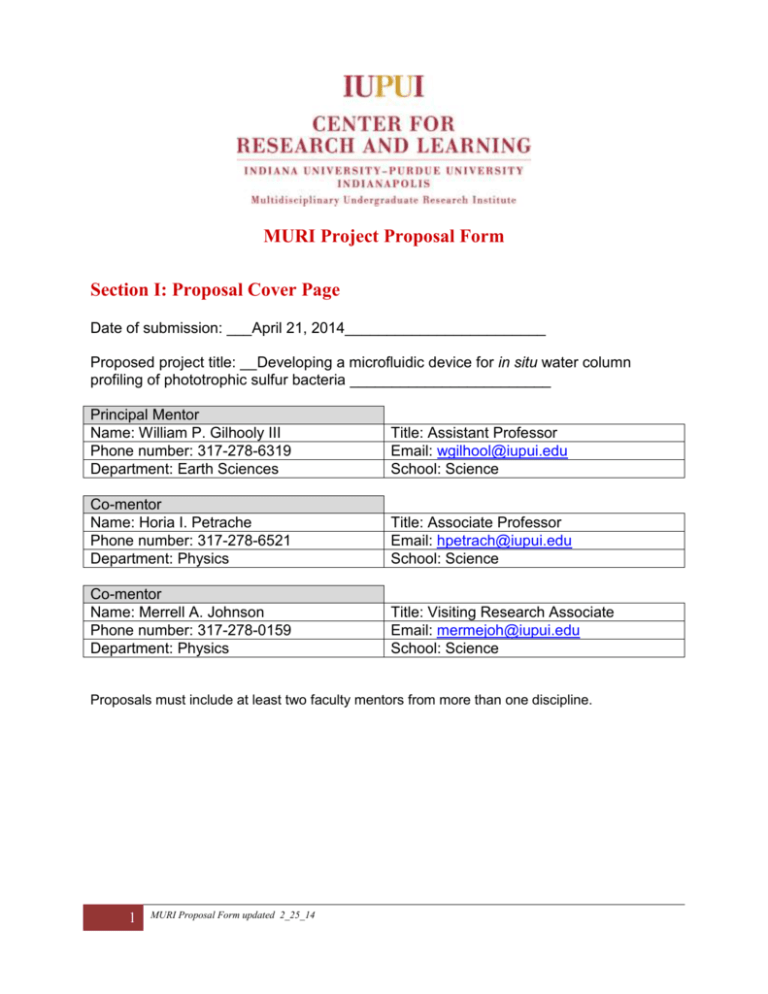
MURI Project Proposal Form Section I: Proposal Cover Page Date of submission: ___April 21, 2014________________________ Proposed project title: __Developing a microfluidic device for in situ water column profiling of phototrophic sulfur bacteria ________________________ Principal Mentor Name: William P. Gilhooly III Phone number: 317-278-6319 Department: Earth Sciences Title: Assistant Professor Email: wgilhool@iupui.edu School: Science Co-mentor Name: Horia I. Petrache Phone number: 317-278-6521 Department: Physics Title: Associate Professor Email: hpetrach@iupui.edu School: Science Co-mentor Name: Merrell A. Johnson Phone number: 317-278-0159 Department: Physics Title: Visiting Research Associate Email: mermejoh@iupui.edu School: Science Proposals must include at least two faculty mentors from more than one discipline. 1 MURI Proposal Form updated 2_25_14 Section II: Student Request Page Total number of students requested: 6 (Note: The total number of students must exceed by two the number of mentors) Total Number of freshmen and/or sophomores to be recruited: 3 (Note: Preference will be given to projects that include at least one freshman and/or sophomore) Disciplines or majors of students (preference will be given to projects that include at least two disciplines or majors): Geology, Environmental Science, Physics, Chemistry, Biology Skills expected from students: Basic chemistry; laboratory experience in geology, physics, chemistry, or biology; willingness to work outside to collect field samples __________________________________________________________________________________ Names of students you request to work on this project. (Mentors are invited to recommend students that they would prefer to work on the proposed project. Please provide an email address and a rationale; for example, a student may have an essential skill, may already be working on a similar project, or may be intending to apply to graduate school to pursue the same area of research.) The Center for Research and Learning will consider the students requested below, but cannot guarantee placement of specific students on teams. Name of Student: 1) Simran Gurdasani Student’s Email: simran5396@hotmail.com Rationale: Has experience with the biophysics lab 2) Hannah Caito hlcaito@iupui.edu Has experience with the biophysics lab 3) Eric Alt ealt@umail.iu.edu has experience in biogeochemistry lab 4) John Byer jwbyer@iupui.edu freshman Geology student 5) Alyssa Henke henkea@indiana.edu freshman Geology student 6) Kyle Puls pulsk@iupui.edu freshman Geology student 2 MURI Proposal Form updated 2_25_14 3 MURI Proposal Form updated 2_25_14 Section III: Body of Proposal (A maximum of 5 pages is allowed for answers to questions 1-13.) Pigment analysis can be used to determine the taxonomic diversity of photosynthetic microorganisms in situ because, i) phytoplankton and photosynthetic bacteria use specific light harvesting chlorophylls or carotenoids, and ii) these light harvesting pigments have unique spectral signatures (Hubas et al., 2011). We propose to develop an in situ device to measure the spectral composition of photosynthetic bacteria in anoxic lakes. Unlike plants that produce oxygen during photosynthesis, phototrophic sulfur bacteria use sulfide and sunlight to produce carbohydrates and elemental sulfur. These unique phototrophs live in close association with sulfate reducing bacteria, which generate hydrogen sulfide during organic matter decomposition (Gilhooly et al., 2014, in revision). Northern Indiana has many anoxic lakes and one such location is Lake of the Woods (Figure 1). This lake hosts a purple bacterium, the water column is anoxic, and the sulfur chemistry suggests that dissolved sulfide is actively produced in the water column (Gilhooly, unpublished data). These redox conditions and light availability suggest that the Lake of the Woods water column is conducive to blooms of phototrophic sulfur bacteria. Other anoxic lakes in Indiana that are likely candidates for supporting the growth of these bacteria include Smith Hole, Pretty Lake and Martin Lake. Although there are likely many local study areas, sampling these organisms tends to be problematic because: i) measurement devices tend to be large and prone to physically mixing the water column, and ii) the thickness of the bacterial plate is usually very thin (cm’s) relative to the sampling resolution (m’s). Microfluidics is a novel technology for developing small volume, continuous-flow devices that can be used to deploy instrumentation natural environmental settings without disturbing the in situ conditions (e.g. temperature and oxygen concentrations) (Di Caprio et al., 2013). The project will develop and test various microfluidic devices to measure the spectral signatures of photosynthetic bacteria in anoxic lakes. Figure 1. Preliminary data from an anoxic lake, Lake of the Woods, Indiana (41°25’23.96”N, 86°13’47.18”W). An unidentified (A) purple bacterium was deposited along the shoreline. Sulfur chemistry (B) shows sulfate concentrations decrease with depth and sulfur isotope values increase with depth, consistent with microbial sulfate reduction, and sulfide production. Water column data (C) indicates oxygen and solar radiation are consumed within the upper 4 m of the lake. 4 MURI Proposal Form updated 2_25_14 1) What are the research objectives for the proposed project? This multidisciplinary project will develop a robust analytical device for measuring the in situ spectra of phototrophic microorganisms within anoxic lakes. These measurements can potentially provide qualitative information about the identity and abundance of phototrophic bacteria with the lakes. The objectives are as follows: 1. Design and build a microfluidic device that can be attached to a pump sampler, deployed underwater, and used to measure the in situ spectra of phototrophic sulfur bacteria. 2. Perform tests to streamline the shape of the device to prevent turbulent mixing within the water column when the device is deployed in the water. 3. Perform bench-top spectral analyses with the device on environmental samples and microbial cultures. 4. Deploy the device in a number of lakes with known phototrophic sulfur microbial plates and perform spectral analysis. Also collect chemical and environmental data to provide context of redox conditions, light availability, and nutrients. 5. Compare spectra of bench-top measurements and in situ measurements with spectra published in the literature. 2) What specific research question(s) will your proposed project address? 1. What are the spectra that can be used to uniquely identify the presence of purple sulfur bacteria and green sulfur bacteria? 2. What is the vertical distribution of phototrophic sulfur bacteria within the lake? 3. What environmental conditions promote the growth of purple sulfur bacteria and green sulfur bacteria? Are there specific levels of sulfide, nutrients, and light that enhance the productivity of these phototrophs? 4. Can the relative predominance or presence of either purple sulfur bacteria or green sulfur bacteria be used to determine the chemical and redox composition of the water column? 5. How does the vertical distribution of phototrophic sulfur bacteria change diurnally and seasonally? 3) What is the significance of this research? Several lines of geochemical evidence suggest that the coastal margins during the Cretaceous (145-66 million years ago) were anoxic and sulfidic (Owens et al., 2013). Known as ocean anoxic events, these periods of low oxygen are expected to occur again given the current pace of climate change, as dissolved oxygen solubility decreases with increasing seawater temperatures (Falkowski et al., 2011). Phototrophic sulfur bacteria sulfur bacteria grow where water column sulfide migrates into the photic zone, a region known as ‘photic zone exunia’. Studying the growth of purple and green sulfur bacteria in modern anoxic lakes can provide better constraints on environmental conditions that may have prevailed in the past and are projected outcomes of climate change. Pigment analysis has been used to quantify population dynamics of microscopic phytoplankton in lakes and the ocean. The chlorophyll content of a natural sample can be measured by standard spectrophotometric techniques; however the method requires several milliliters of water and the sample collection tends to mix and disturb the redox conditions of the lake. The method is also time consuming, and of low spatial resolution relative to the centimeter thickness of the microbial plate. 5 MURI Proposal Form updated 2_25_14 Designing a new, flow-through, method to determine the in situ microbial composition of phototropic sulfur bacteria will enable a more accurate and less invasive assessment of the anoxygenic photosynthesizers. 4) Why does this proposal offer a good opportunity for undergraduate researchers to gain substantive research skills? The undergraduate students will have the unique opportunity to participate in a project that combines lab work and fieldwork. Such projects tend to be mutually exclusive; however, environmental studies such as these are best informed by both approaches. The students will learn about microbial metabolisms, ecological constraints on microbial activity, and the use of stable isotopes as environmental tracers. In addition to this knowledge, the students will develop a skill set in designing and making microfluidic devices, collecting environmental samples in the field, and measuring the stable isotope compositions. The students will benefit from this interdisciplinary collaboration between Petrache’s physics laboratory and Gilhooly’s biogeochemistry laboratory with the assistance of Merrell Johnson, a visiting research associate with experience on microfluidic devices. Combined, these laboratories have 2 graduate students and 4 undergraduate students with research experience with whom the MURI students will interact with. Students will be mentored and trained jointly by Petrache, Gilhooly, and Johnson. 5) What research methodology and specific tasks will students and mentors undertake? 1. In accordance with EHS guidelines, mentors will provide laboratory safety training for all students involved in the research project. Lab methods will be demonstrated to all students to ensure that the entire research group is familiar with the full range of skills and procedures used for the project. All students will be encouraged to participate in the field sampling of the lakes. Prior to the fieldwork, Gilhooly will confirm whether the students can swim, and will give a safety lecture about working on small boats and with field equipment. 2. Sample preparation and analysis will be conducted on lab equipment in Petrache’s and Gilhooly’s labs. Students will be responsible for sample preparation under the supervision of Petrache, Gilhooly, and Johnson. 3. Microfluidic devices will be designed and made by the students in Petrache’s laboratory under the supervision of Petrache and Johnson. 4. Field samples will be collected by the students and under the supervision of Gilhooly. 5. Students will prepare and analyze samples for stable isotope composition in Gilhooly’s lab. 6. Students will present their research at university meetings such as IUPUI Research Day and at national meetings. 6) What plan has been designed to ensure effective communication with all co-mentors and undergraduate researchers on the MURI team? Weekly group meetings will be held in the Geology conference room, SL118, which is in a convenient location for both lab groups. The conference room has a computer and projector for displaying Powerpoint presentations and dry-erase boards for writing out problems and ideas. Students will provide updates on the research progress and the group as a whole will have roundtable discussion of results and modifications of the experimental design. An Oncourse project site will be created and access provided to team members in order to share and exchange data. 7) What measureable outcomes and benefits will this research provide to the students, you and your co-mentor(s), your department, and your school? 6 MURI Proposal Form updated 2_25_14 The students will gain extensive experience in laboratory and field-based research, and develop the critical thinking skills needed to succeed in graduate studies. Involvement in active scientific research expands students’ horizons by making them aware of the range of possibilities in science inquiry, and makes them aware of their own academic abilities. Gaining familiarity with lab and field science helps develop self-confidence and has encouraged students in both the Petrache and Gilhooly laboratories to go on to prestigious graduate programs. Mentors Petrache and Gilhooly will benefit from having additional help in conducting idea-driven research. Introducing students with fresh questions and ideas to active research often leads to new directions and observations. These students also add an infectious energy to research projects that helps propel the research forward. Outcomes from this study will also provide a preliminary dataset for a collaborative research proposal to an external funding agency. The Physics and Earth Sciences departments will benefit from the recognition of research presented at university-wide meetings, such as IUPUI Research Days, and national meetings. 8) What is the timeline for the major tasks associated with this proposal? Week 1: Training and introduction to methods Week 2: Collect environmental samples from anoxic lakes in Indiana Week 3-5: Measure chemistry of environmental samples; initial microfluidics designs Week 6-8: Measure spectra of environmental samples with microfluidic proto-type; continue chemical analyses Week 9-11: Spectral analysis and bench-top tests of device; continue chemical analyses Week 12-14: Spectral analysis, data analysis, work on research reports and manuscript drafts Week 15-17: Deploy microfluidic device in anoxic lakes, measure in situ spectra, collect environmental data. Week 18-20: Data analysis; finalize research reports; present at Research Days 9) Please provide a rationale for your budget request. (NOTE: The maximum budget allowance is $2,000 for equipment and/or supplies needed for the research team. Generally speaking, expenditures for computers and/or travel are not approved by the review committee at this time due to financial constraints.) Funds are requested for isotopic and chemical analyses ($1000), and for microfluidics preparation and fabrication ($1000). 10) Please describe your plan for sustaining your research beyond the funding that MURI is able to provide. (For example, please list other external grants that have been or will be submitted as a follow-up to your MURI funding.) This research project is appropriate for proposal submissions to NSF Geobiology and LowTemperature Geochemistry (06030000 EAR) and NASA Astrobiology: Exobiology and Evolutionary Biology (NNH14ZDA001N-EXO). The methodology developed herein is appropriate for a publication in journals such as Geobiology, or Limnology and Oceanography. 11) Please identify any areas relevant to risk management. The students will receive proper laboratory training for physics and biogeochemistry. The project will not involve the use of animals, human subjects, DNA, human pathogens, or radiation. 7 MURI Proposal Form updated 2_25_14 Please check any risk assurances that apply to this proposal: Animals (IACUC Study #): _________________ Human Subjects (IRB Study #): ____________________ r-DNA (IBC Study #): _____________________ Human Pathogens, Blood, Fluids, or Tissues must be identified if used: ______ Radiation : ______ Other : ______ 12) The Center for Research and Learning generally shares the text of funded proposals on the web so that prospective students can learn about available MURI projects. Please let us know if it is OK with you to post your proposal on the CRL MURI webpage by checking one of the following answers: YES NO NOTE: If you indicated that it is not OK to share your full proposal via the web, you will be asked to send us a few short summary paragraphs that can be used to describe your project to potential undergraduate scholars. These will be posted on the MURI website and attached to the application for the students to review. 13) Please indicate any dates that mentors will not be available for students during the summer such as planned vacations, conferences, etc. Section IV: References/Bibliography (insert 1-2 pages as needed) Di Caprio G, Schaak D, Schonbrun E (2013) Hyperspectral fluorescence microfluidic (HFM) microscopy. Biomed. Opt. Express, 4, 1486-1493. Falkowski PG, Algeo T, Codispoti L, Deutsch C, Emerson S, Hales B, Huey RB, Jenkins WJ, Kump LR, Levin LA, Lyons TW, Nelson NB, Schofield OS, Summons R, Talley LD, Thomas E, Whitney F, Pilcher CB (2011) Ocean deoxygenation: Past, present, and future. Eos, Transactions American Geophysical Union, 92, 409-410. Gilhooly WP, Reinhard C, Lyons TW (2014, in revision) A comprehensive sulfur and oxygen isotope study of sulfur cycling in a shallow, hyper-euxinic meromictic lake. Geochimica et Cosmochimica Acta. Hubas C, Jesus B Fau - Passarelli C, Passarelli C Fau - Jeanthon C, Jeanthon C (2011) Tools providing new insight into coastal anoxygenic purple bacterial mats: review and perspectives. Research in Microbiology, 162, 858-868. Owens JD, Gill BC, Jenkyns HC, Bates SM, Severmann S, Kuypers MMM, Woodfine RG, Lyons TW (2013) Sulfur isotopes track the global extent and dynamics of euxinia during Cretaceous Oceanic Anoxic Event 2. Proceedings of the National Academy of Sciences, 110, 18407-18412. 8 MURI Proposal Form updated 2_25_14 Section V: CVs/Resumes (insert 2 pages per mentor for a maximum of 6 pages) See attached pdfs. Section VI: Support Letters (insert 1- 2 pages as needed) Section VII: Appendix (Title of and information on the status and outcomes of the past Student Multidisciplinary Research Team projects received by the Principal Mentor and/or any of the Co-Mentors must be detailed here. Please insert 1-3-page summary per previous MURI project as needed according to template below.) Section VII: Appendix -- Part I Title of Past MURI Project: Electrical properties of biological materials under DC and AC applied signals Date Awarded: Summer 2013 Date Completed: August 2013 Description of Project: In this multidisciplinary project we investigated electrical properties of a series of biological materials, primarily lipid membranes with and without ion channels and protein networks made of fibrinogen molecules found in blood. Mentors Involved in Project: Horia I. Petrache, Elliot D. Rosen, and Yogesh N. Joglekar 9 MURI Proposal Form updated 2_25_14 Students Involved in Project: Vannara Chhim, Yuncong Hao, Qurat-ul-Ann Mirza, Dan Preston, Alexander Walls, Raquel Zacherl Description of Basic Project-related Student Learning Outcomes: Vannara Chhim worked on ion current measurements and on computer programming Yuncong Hao worked primarily on measurements of electrical properties of samples used for ion current measurements Quarat-ul-Ann Mirza worked on theoretical calculations Dan Preston worked on measurements of electrical properties of solutions and membranes under DC signals Alexander Walls worked on AC measurements Raquel Zacherl worked on NMR measurements of solutions used for DC and AC studies Three posters were presented at IUPUI at the end of the summer program in 2013 and two posters were presented at the Biophysical Society meeting in San Francisco (February 2014). Alexander Walls was the first author on one of these posters at the Biophysical Society meeting. He could not attend but my other students presented the poster for him. Section VII: Appendix -- Part II NOTE: MURI receives funding for a INSCG, and we are required to report on the following outcomes for projects: Publications/Presentations # Faculty Mentors How many authors have published results of this research/activity? How many authors have submitted manuscripts on this research/activity that are not yet published? 10 MURI Proposal Form updated 2_25_14 # Undergraduate Scholars Names of Participating Mentors/Undergraduate Scholars How many invited papers were presented based on this research/activity? How many peer-reviewed presentations at conferences were based on this research/activity? Proposal Development # Faculty Mentors How many proposals for additional funding based on this research/activity were submitted this year? Total dollar value of the amount requested on submitted proposals? How many of these proposals were funded this year? Total dollar value of the amount received through funded proposals? 11 MURI Proposal Form updated 2_25_14 # Undergraduate Scholars Names of Participating Mentors/Undergraduate Scholars Patents # Faculty Mentors # Undergraduate Scholars Names of Participating Mentors/Undergraduate Scholars How many related patents have been applied for? How many related patents have been granted? How many patent licenses have been issued based on this research/activity? Technology Transfer # Faculty Mentors # Undergraduate Scholars Names of Participating Mentors/Undergraduate Scholars How many technology transfer activities resulted from this research/activity? Section VIII: Signature Name and Signature of the Principal Mentor: (typing in the full name suffices as signature for electronic copies) William P. Gilhooly III Name 12 MURI Proposal Form updated 2_25_14 William P. Gilhooly III Signature 4/21/14 Date



